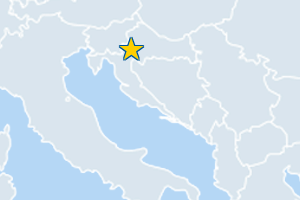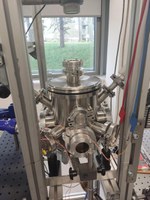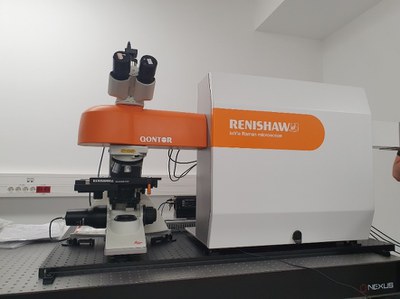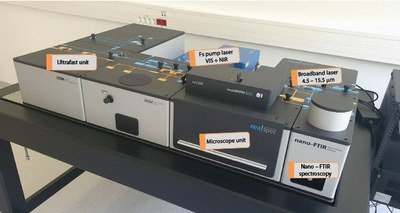CALT (Zagreb, Croatia)
Research Highlights
CALT
Centre for Advanced Laser Techniques
Institute of Physics (IFZg), Zagreb, Croatia

Contacts:
IFZg research highlight are in the field of ultrafast laser spectroscopy (femtosecond and frequency comb spectroscopy), cold atoms, plasma physics (laser and plasma spectroscopy), nanostructures and surfaces, hybrid systems and biophysics, electronic states and physical properties of new materials (superconductivity, magnetism, electronic charge and spin superstructures, new collective states), and modelling of complex systems.
Expertise
The key IFZg research topics which employ laser techniques are: frequency comb mediated optomechanical effects in cold atoms, quantum light-matter interfaces; laser produced plasma, plasma application for material processing and the formation of nanostructures; structural and electronic properties of clean surfaces, ultra-thin films, assisted nanostructures, and graphene and 2D materials on well-defined surfaces; new materials of highly anisotropic crystal and electronic structures, with charge and spin density waves, and dynamics on ultrashort time scale.
Expertise in recyclable materials
 Controllable synthesis of nanomaterials and their optical, electronic, chemical, structural, morphological and surface characterization. By tuning the synthesis parameters, new functionalities and properties arise as the next step in the value chain from the fundamental research toward final product. Various non-invasive spectroscopic techniques (UV-VIS-NIR, absorption, photoluminescence, Raman spectroscopy, FTIR, nano-FTIR, transient absorption spectroscopy, time-resolved photoemission) together with scanning probe techniques (Atomic Force Microscopy, Scanning Electron Microscopy) will be available.
Controllable synthesis of nanomaterials and their optical, electronic, chemical, structural, morphological and surface characterization. By tuning the synthesis parameters, new functionalities and properties arise as the next step in the value chain from the fundamental research toward final product. Various non-invasive spectroscopic techniques (UV-VIS-NIR, absorption, photoluminescence, Raman spectroscopy, FTIR, nano-FTIR, transient absorption spectroscopy, time-resolved photoemission) together with scanning probe techniques (Atomic Force Microscopy, Scanning Electron Microscopy) will be available.
Services for industry
Electronics
Materials development, Characterization, Microscopy, Testing, Training - Expertise in two-dimensional (2D) materials synthesis and characterization for electronic applications.
Semiconductors
Materials development, Characterization, Microscopy, Testing, Training - Expertise in semiconducting nanomaterials optical and strucutural characterization for applications in solar cells, nanoscale electronic devices, light-emitting devices, laser technology, sensors, etc.
Automotive
Characterization, Testing, Training - Li-ion batteries have emerged as the battery of choice for electric vehicles. Significant research efforts are devoted to identifying materials that offer higher-capacity for commercial applications. We provide optical and structural characterization tools for rechargeable lithium-ion batteries, with a focus on the structural and electrochemical degradation mechanisms.
Agriculture
Characterization, Microscopy, Resting, Training - Structure and chemical composition of cereal grains directly influence their processability, and how they influence human digestion systems. Raman spectroscopy and imaging enables us to reveal chemical composition and the spatial distribution of components in a cross section of a grain kernel.
For more information, contact the Laserlab Office.
Search for other industry services>>
Equipment offered to external users
Commercial laser systems: Nd:YAG laser (850mJ, w, 2w, 3w, 4w) and DYE laser (CRD Spectroscopy for laser plasma, atmospheric plasma and gasses detection/characterization).

PLD chamber: Pulsed laser deposition (PLD) system for fabrication of thin films.
Workstation for laser synthesis of nanoparticles: Workstation for laser synthesis of colloidal nanoparticles by pulsed laser ablation.
Workstation for photocatalysis: Workstation for photocatalysis of different solutions.
Workstation for nanoparticle characterization: Workstation for nanoparticle characterization – ICP-OES, Nanosizer, DLS, Z-potential, photoluminescence, FT-IR, UV-Vis-NIR with integrating sphere, contact angle.
Femtosecond One Box Amplifier: Commercial laser system: femtosecond One Box Amplifier: <100 fs; 7 mJ/pulse, 1 kHz rep.rate + OPA1: 290-580 nm + OPA2: 480-1150 nm; Oscillator Vitara: 800 nm (tunability 755-860 nm), 550 mW, 80 MHz rep. rate. System will be used for transient absorption spectroscopy.
Femtosecond high repetition rate system: Commercial laser system: femtosecond laser, 60 uJ/pulse, 290 fs pulse duration + OPA 700-900 nm, 20-30 fs, >3.6μJ/pulse + SHG 350-450 nm, 20-30 fs.
 Raman Spectrometer: Commercial Renishaw custom made Raman spectrometer based on confocal microscope, 532 nm excitation laser, suitable for measurements of low-level signals, for measurements in optical and magneto-optical cryostats, polarization resolved measurements and low-energy Raman modes.
Raman Spectrometer: Commercial Renishaw custom made Raman spectrometer based on confocal microscope, 532 nm excitation laser, suitable for measurements of low-level signals, for measurements in optical and magneto-optical cryostats, polarization resolved measurements and low-energy Raman modes.
AFM microscope: AFM microscope performing in tapping and in contact modes, for AFM imaging in the air and liquids, with modules and modes for electrical measurements such as KPFM, conductive-AFM, MFM (magnetic) and PFM (piezoresponce) modules, quantitative imaging for Young module measurements. Fast speed imaging up to 300 Hz enables atomic resolution and fast scanning capabilities on a single platform. Anti-vibrational rack an acoustic enclosure provide the mechanical and thermal stability to afford time laps imaging. Stretching Stage can apply an external mechanical load to the sample, while the AFM measures variation of the sample properties in-situ.
SEM microscope: LaB6 filament; accelerating voltage: 200 V-30 kV; best resolution 2 nm @ 30 kV (high vacuum) and 2.5 nm @ 30 kV (low vacuum); 185-850 nm panchromatic CL detector; high count rate silicon drift EDS system capable of analysis for elements in the range from Be to Pu.
 s-SNOM (near-field) microscope: Commercial neaSPEC s-SNOM (near-field) microscope with nano-FTIR and pump-probe spectroscopy options at <150 fs temporal and 25 nm spatial resolution in mid-IR spectral region (probe 5-15 um, pump: 480-960 nm)
s-SNOM (near-field) microscope: Commercial neaSPEC s-SNOM (near-field) microscope with nano-FTIR and pump-probe spectroscopy options at <150 fs temporal and 25 nm spatial resolution in mid-IR spectral region (probe 5-15 um, pump: 480-960 nm)

